Photography and film making win the biggest art prize in the UK!
In November, when I saw the Arts Mundi 7 exhibition on an OCA study day, I had very little time to watch Akomfrah’s exhibit. We had spent more time than we should have at the previous 4 exhibits so we had to rush to get to the last one. There was something drawing me to this but I just put it down to my interest in the subject rather than to the rationale behind it. My review of it was, therefore, rather dismissive. Two of us decided that we were going to come back to Cardiff, to the conference to hear the artists speaking about their work, which we did on 25th January, 2017.
Every single presentation surprised me. Some because of their delivery, others because of their content. The lecture hall was in darkness so I had to guess what I was scribbling and consequently, some of the notes were totally undecipherable.
First up was frenetic Neïl Beloufa who could not get his laptop to connect with the technology in the theatre. Was this, being so true to his MO, part of his performance? I asked him as we were waiting in the queue for coffee afterwards and he said it wasn’t – but it was a good idea and something to keep up his sleeve for the next time it happens, being the opportunist that he is!
His presentation started with a little cartoon about a social gathering in a sharks restaurant in which one of the shark diners states that he won’t have crab because he is vegetarian. There is a sharp intake of breath from the other sharks as the power struggle starts.
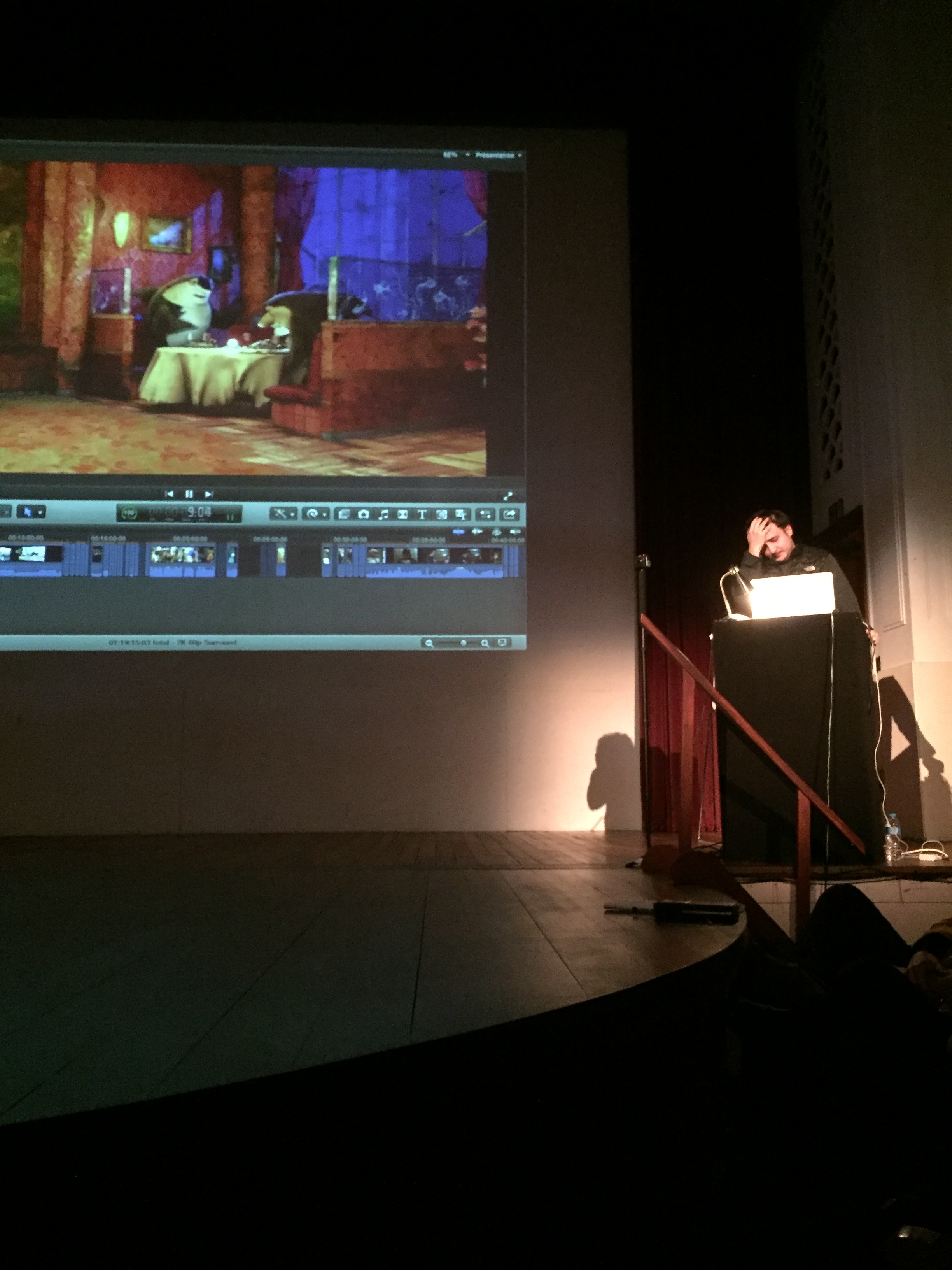
In his presentation, he gave us some ideas of how he challenges authority; how he makes the people he works with feel that they have some control over how the project is developing. Basic to his artwork is his desire to break down authority and power relationships.
His presentation was in keeping with his art work.
He comes across as a self-professed opportunist, boyish anarchist & it’s a persona he cultivates carefully. In the coffee queue, I asked him if he would ever consider collaborating with Nastio Mosquito whose anti-authority presentation we had just seen, and his response was an immediate and unequivocal “NO!” The potential power struggle was very evident in the explosive reply.
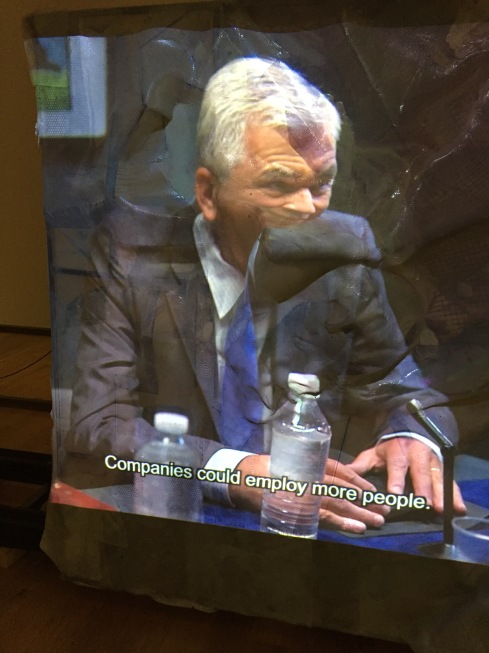
Next up was Amy Franceschini representing “Future Farmers”. The project is a socially engaged one taking us back to re-forming communities via seed exchanges & story telling & festivals which eschew the acceptance of standardised, modified seeds sold internationally by multi-nationals in preference for locally grown seeds.
In November I thought that this was a multi-stranded, well exposed exhibition in which the artistic element was very strong. At the conference, what came out very strongly was the social element of their project which shifted the weight of the exhibit away from art. Future Farmers are to be applauded for using this platform for raising awareness of what they are doing which, in my opinion, needs to be done. Amy stressed that the main message is that they do not want the seeds to be stored in museums or laboratories, they want them planted and used.
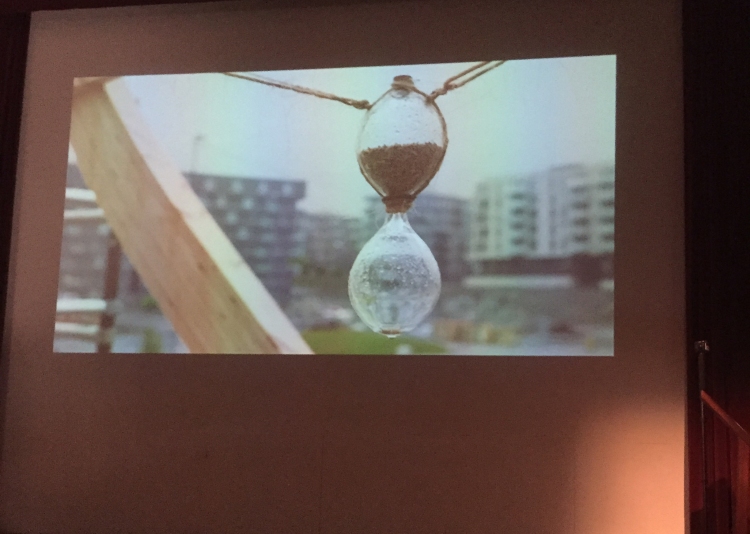
Nástio Mosquito was on a blacked-out stage, indistinguishable from the curtains. He waited for silence then started to speak about meeting Noah with some friends, like a herd of animals, which made no sense to me at the time or afterwards. Then he started singing a song which sounded like a Negro Spiritual song and had the refrain: ” You speak about power like you know what it is.” At the end of the song there was dead silence. The performance lasted for about 10 minutes and was like an extension of the exhibition. The artist sat down & eventually the auditorium lights came on. Unlike previous presentations, the audience was not asked if they had questions for the artist. This was a pity but we had to accept it.
As the performance was in addition to the exhibition rather than an exposition of its rationale, I did not feel that I had understood his work better.
Lamia Joreige was the only artist to give an academic lecture which gave us insights into what she was trying to achieve.
In the project Objects of War (1999 – ongoing), she is trying to re-access the history of Lebanon through objects and people’s links to those objects and recollection of events in order to expose a personal history. Through this she uncovered fragments of history which bordered on fiction and discovered that there is no hierarchy in objects of war. She came to ask if history can be captured by a fragmented image – the exercise seemed at times to be a crime scene reconstruction.
Her phrases “Un ailleur inaccessible; un bonheur endormi” = ” an inaccessible elsewhere; a happiness fast asleep” for me caught the essence of her work and the nostalgic tone of her presentation. The idea of elsewhere was picked up again by John Akomfrah in his presentation.
Her “Objects missing” section told of the inaccessibility of pertinent information which had been ‘lost’; an archive which may or may not have existed. The book which lists the missing objects is itself inaccessible – behind a glass case never to be opened.
In diagnosing the present, Lamia presents us with a fragmented, subjective and, to date, incomplete image of the past. Photographic images, drawings, paintings, archives, sculptures and film recordings all rooted in memory, make hers a very rich exhibition which viewers can access in many ways.
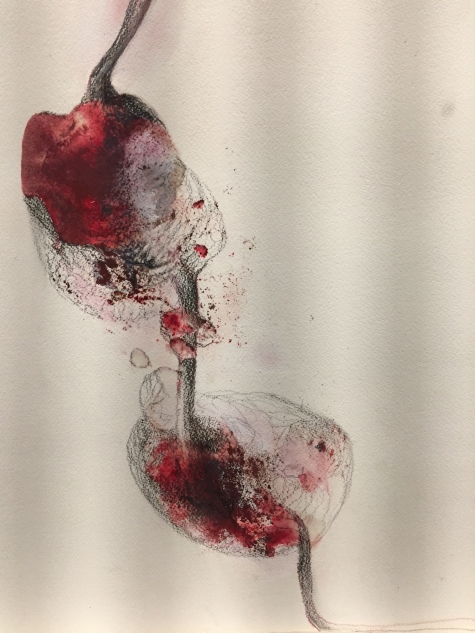
Bedwyr Williams‘ presentation was a performance in the character of a vicar / minister / priest in which he lampooned various stereotypes. His humour was engaging and original. The 4 minutes of church music and choral singing (probably in Welsh) which introduced his presentation, although superb in their genre, told me very little about the artist or his work in the exhibition.
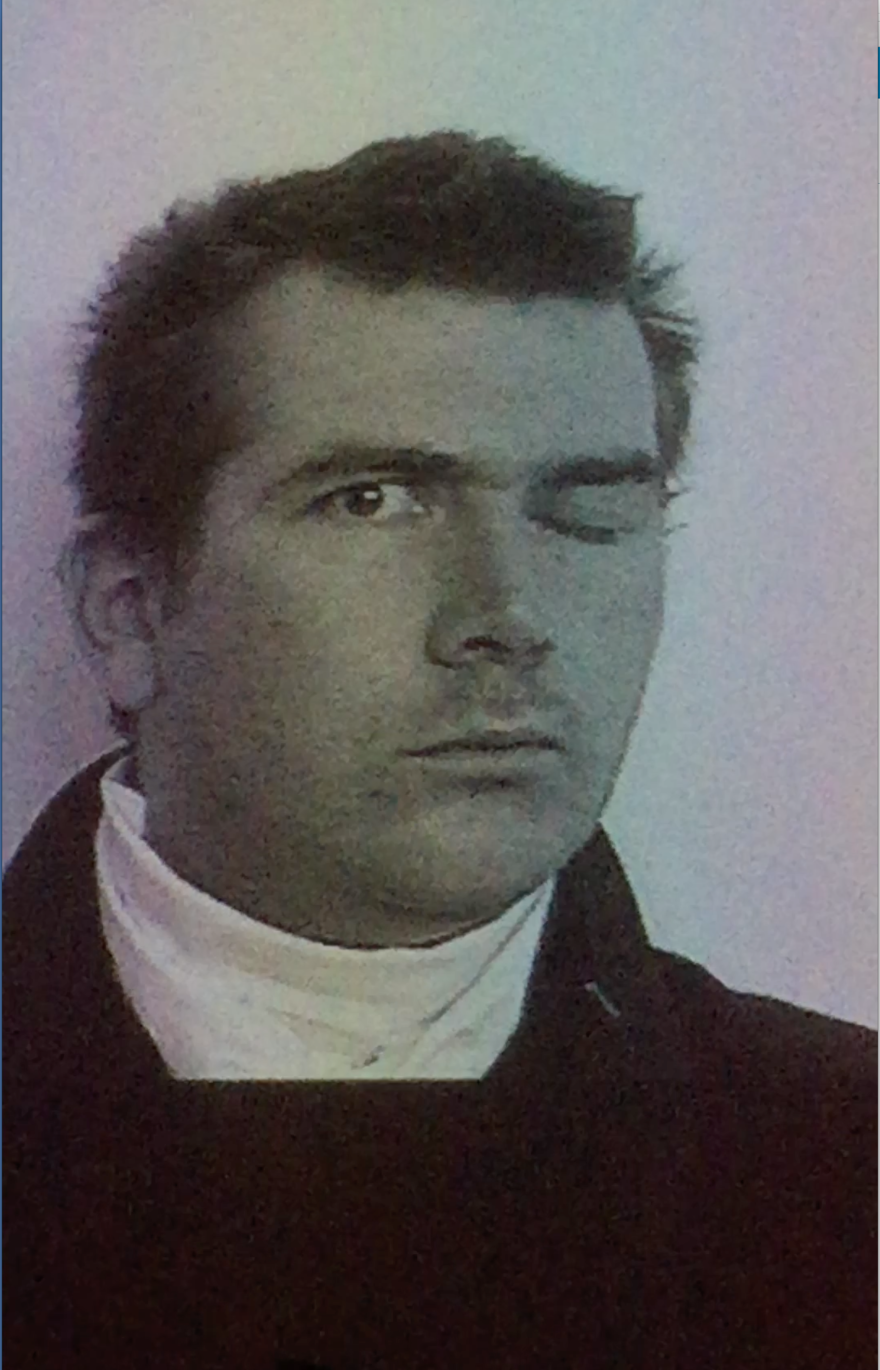
John Akomfrah’s was for me the pinnacle of the artists’ presentations. His talk opened my eyes as to what I had been looking at so briefly in November. He spoke about images being a repository of a haunting, the uncanny, the strange, the eerie. He sees images as a ‘contest of sight’. Through films and stills from those films, John spoke about an ‘elsewhere’ evident in an image: in the following still from the film ‘Shoah’, John spoke about the haunting element of the image: the subject is both with you and elsewhere at the same time. “the promise of the image is that the viewer will see the the image at some point in the future, but you won’t because it will always be elsewhere.” He describes that ‘elsewhere as ‘ the incantatory logic of story telling’.
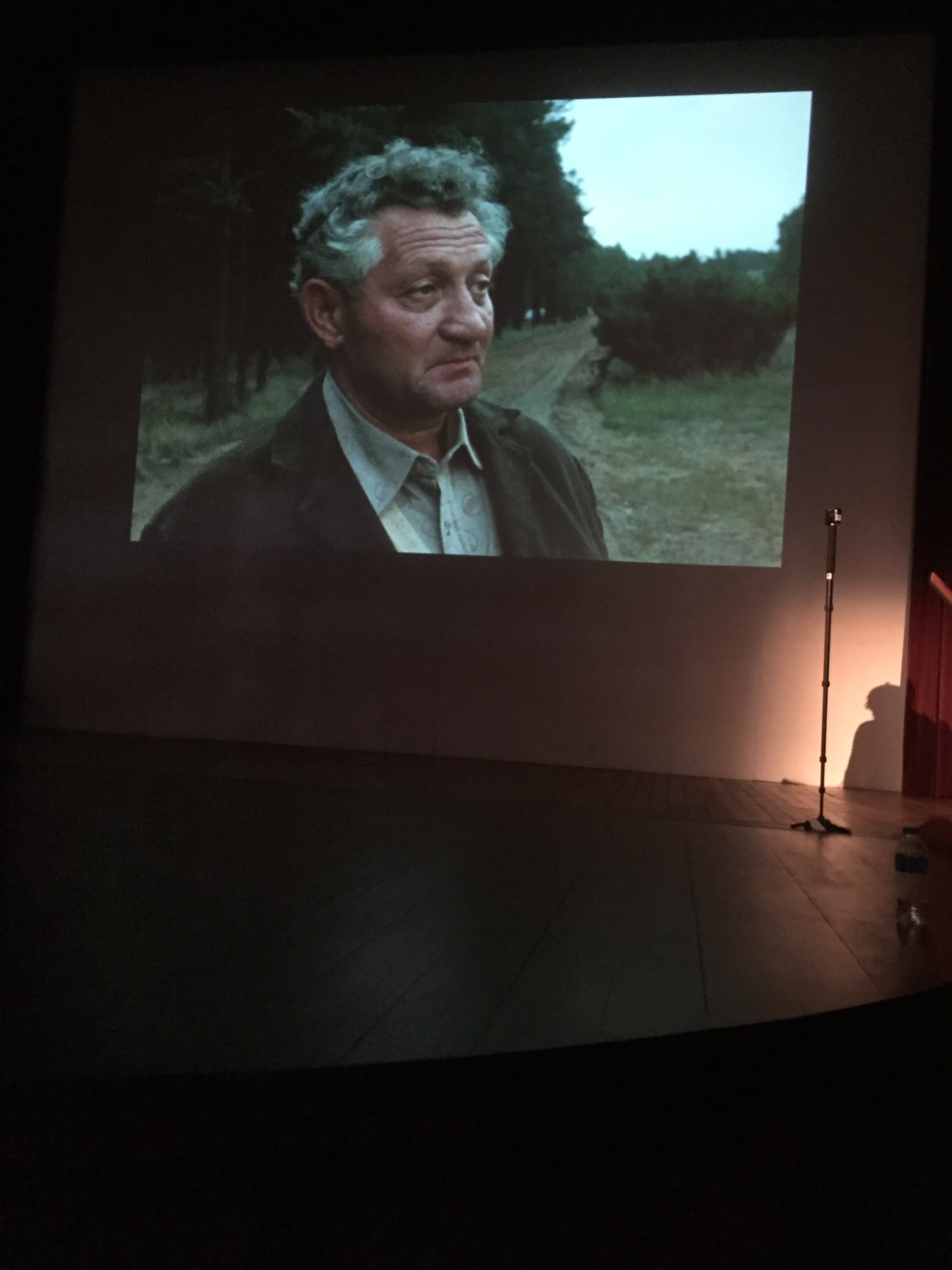
In looking at images, John tries to find the elsewhere in banalities too, and illustrated this through the film recorded in 1964 in Bethel Baptist Church, Houndsworth. In it someone says: “We are going to perform normality for you” … “You will see us not being niggers, being normal.”
In analysing archived images, John asks “What is this image trying to say to me? That image only exists so that, in that moment you have a bond with it.” He sees that as the underscore of every image.
In putting work together, John asks himself if, after all his research, he is doing his work justice. Is he being true to the work?
He sees the archive as constructed material / language and asks how the image evokes that material. He sees a shift in the meaning of the archive depending on where it resides. Everything about an image is haunted by the past. Finally, he said”We need to widen the meaning of the archive.”
What was so striking about this presentation was the artist’s integrity and humility vis a vis images and humanity. His presentation spoke of his work to which he is evidently deeply committed and which is so desperately relevant with the mass migrations of people today. He brought ‘hauntology’ home to me and made me realise that it is evident in all images: it is a composition of past, present and future and I am certain that it will affect, consciously or subconsciously, how I will see and make images from now on.
At the panel discussions after the presentations, it was evident that some artists were more prepared to speak than others. Bedwyr looked very uncomfortable and said, after one of the questions that he was very tired and felt that he could not answer. Lamia spoke very little while, the others all took it in turns to answer.
I asked one of the selectors, Alistair Hudson – Director of the Middlesbrough Institute of Modern Art -, if it was a coincidence that all the exhibits were mediated through language, either spoken or written or both, and if this was a conscious criterion on the part of the selectors. He had not considered it & said that it was not one of the criteria for selection.
As a language teacher, I wondered how language worked at a subliminal level in the selection process & found this cross-over very significant: six art works have been selected in an international competition from a submission of over 800 and they all have language as an integral and essential part of their installation to deliver their message. That language emerged in film scripts as sub-titles; film narratives; spoken and subtitled translations in films; folk tales; archive materials … the list could go on.
When you have so many art works to consider, you need all the help you can get to understand what the message is so, is it logical to accept that selectors are going to go for the art work ‘explicated’ via language ?

What a rich day. The work of Joreige and Akomfrah particularly resonate with me and you’ve picked out some additional aspects that attract me. I’m obviously now going to have to read extensively on ‘hauntology’ which at the moment seems to be such a mix of ideas/influences – material,emotional and ethereal. Good for you for picking up on the language aspect. I missed the film ‘Arrival’ when it came locally but it’s on my want to watch list. That film is also so pertinent to language and communication. Writing of that reminds me of the new President of the US vocal expression but I’ll desist so as to stay positive.
I felt very absorbed reading about this day Anna.
LikeLike
I am so glad I went & that Paddy was there too to bounce ideas off. I can’t believe how often ‘hauntology’ has come up in the last few days – almost as if it’s a fast-spreading rash! The Akomfrah effect, as I will call it now, will be felt far & wide, I think. Glad you enjoyed the write-up.
LikeLike